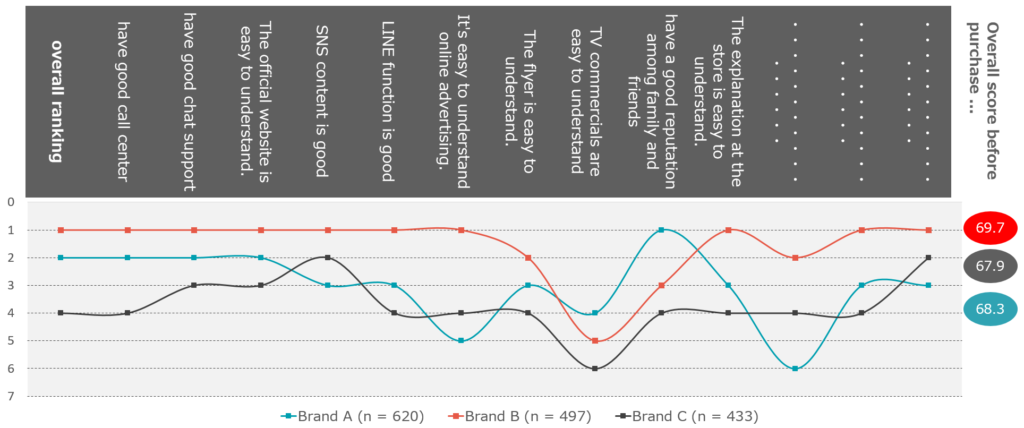This article introduces the “5ALoyalty Diagnosis” service, which allows you to engage in loyalty marketing based on the original indicators proposed by Philip Kotler, the “father of modern marketing”.
This is a five-part series on why loyalty marketing is needed now, and the purpose and benefits of the service. In this fourth series, we will explain CX Diagnosis, the third module of the “5A Loyalty Diagnosis”.

Contents
What is CX (Customer Experience)?
In this article, we will introduce CX diagnosis and what measurements can be made. As we have mentioned in previous articles, the “5A Loyalty Diagnosis” solution consists of three modules. The first is the 5A diagnosis, which measures the 5As themselves, such as the strength and weakness of loyalty, the second is the perception diagnosis, which clarifies the reasons for the strength and weakness of loyalty, and the third is the CX diagnosis, which we introduce in this article.
First, what is CX? CX = Customer Experience is the experience that results from all touch points of interaction and relationship between a customer and a company throughout the customer lifecycle, from the pre-purchase phase to the actual purchase, and even after the purchase.
Changes in touchpoints
Consumers have many touch points with companies, products, and brands. In old-style marketing, the so-called mass media was the only bridge between consumers and companies. Therefore, once the content of how information should be disseminated through mass media was determined, one of the 4Ps, promotion strategy, could be completed. However, in the current wave of the DX era, We are sure that everyone reading this article is making full use of the Internet, e-mail, social networking services, and many other things. We have moved from an era in which mass media was the only connection between consumers and companies to one in which there are now numerous touchpoints and points of contact. This is a time when marketing has changed and also become more difficult. In such cases, CX diagnosis is the best way to understand whether loyalty is strong or weak, and if you know why, to measure what points of contact you should use to communicate your products and services. Without these three perspectives in place, it is not really a real solution. And the question of “which contact points are most efficient to utilize” as measured by this CX diagnosis is a very difficult one. This is because there are TV ads and Internet ads, and even within the Internet, mail magazine ads and SNS content, and there are a variety of options in terms of which and how they can be effective for consumers.
What the CX diagnosis reveals
Our “5A Loyalty Diagnosis” CX diagnosis offers a solution to this difficult problem. Mainly, the CX contact points before purchase (contact points between customer and company) and after purchase can be investigated to visualize the best touch points. Thus, in terms of pre-purchase, it includes all possible points of contact, from in-store, TV ads, packaging, and digital email newsletters to social networking sites. Normally we have over 30 potential points of contact when researching CX points of contact. And for these 30 points of contact, the tool is designed to quantitatively demonstrate, for example, when we want to improve the image of my company, which contact point should we use? which contact point is the most efficient when we want to increase purchases? which contact points are the most effective when we want to strengthen long-term brand loyalty?

“5A Loyalty Diagnosis” Summary
To wrap up, “5A Loyalty Diagnostics” is a quantitative solution that identifies the strengths and weaknesses of loyalty, and visualizes the reasons why and how to address them by defining and communicating them according to customer needs. It is a tool for building a new era of loyalty marketing strategies, as described by Philip Kotler in Marketing 3.0 – 5.0, to respond to the changing marketing landscape. In order to implement marketing in the digital world, it will definitely become important to incorporate the perspective of loyalty, not just traditional marketing strategies. “5A Loyalty Diagnosis” can provide consistent support for this loyalty marketing, from strategy planning to operations.
(Commentary / transcosmos inc. Tsunehiro Fukushima)
Introduction of 5A Loyalty Diagnosis service; Part 1: Getting Started in Building a Loyalty Marketing Strategy(5 part series)
“Introduction of 5A Loyalty Diagnosis service; Part 2: What is 5A Diagnosis?(5 part series)
“Introduction of 5A Loyalty Diagnosis service; Part 3: What is Perception Diagnosis?(5 part series)
“Introduction of 5A Loyalty Diagnosis service; Part 4: What is CX Diagnosis?(5 part series)
“Introduction of 5A Loyalty Diagnosis service; Part 5: Summary(5 part series)
Tsunehiro Fukushima will direct your marketing efforts
At transcosmos, we offer marketing strategy proposals along the 5A concept advocated by Philip Kotler. For actual proposals, Tsunehiro Fukushima, the commentator of this article, will support loyalty marketing optimized for the digital age. Please tell us your company’s concerns.

Tsunehiro Fukushima
Corporate Executive Officer, transcosmos inc.
Director, Japan Marketing Association
After completing graduate studies at Tokyo Institute of Technology, he joined Ajinomoto Co., Inc. He then worked for GE Capital, Mitsubishi Corporation, Gurunavi, Inc., and Medical Data Vision Co., Ltd., where he served as head of big data business and marketing. His areas of expertise include new business and new product development, brand theory, medical business, and loyalty marketing. At transcosmos, he is in charge of marketing-related business development and is the exclusive provider in Japan of the 5A diagnosis introduced in the book “Kotler’s Marketing 4.0”.

